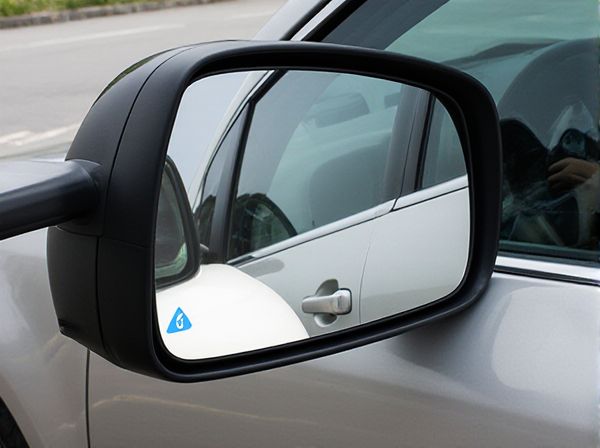
Photo illustration: Auto-folding Mirror vs Manual Folding Mirror
Auto-folding mirrors offer the convenience of electronically retracting your side mirrors with the push of a button, enhancing security and protecting them from damage in tight spaces. Manual folding mirrors require physical effort but are often more reliable and less prone to electrical faults, making them a cost-effective choice for some drivers. Your decision between the two should balance ease of use, maintenance, and durability based on your daily driving needs.
Table of Comparison
| Feature | Auto-folding Mirror | Manual Folding Mirror |
|---|---|---|
| Operation | Electric motor, folds automatically | Manually folded by hand |
| Convenience | High - folds with key fob or door sensors | Low - requires physical effort |
| Safety | Reduces damage risk in tight spaces | Higher risk of damage if not folded properly |
| Cost | Higher initial cost and maintenance | Lower cost and simpler design |
| Installation | Pre-installed on mid to high-end vehicles | Common in economy and older models |
| Durability | More complex, potential electrical issues | Less complex, fewer failure points |
Introduction to Auto-Folding and Manual Folding Mirrors
Auto-folding mirrors use electric motors to automatically fold or unfold the side mirrors with the push of a button or when locking the vehicle, enhancing convenience and protection against damage in tight spaces. Manual folding mirrors require the driver to physically fold the mirrors by hand, often found in older or more basic vehicle models. The choice between auto-folding and manual folding mirrors impacts ease of use, durability, and vehicle technology integration.
How Auto-Folding Mirrors Work
Auto-folding mirrors operate through an integrated motor and sensor system that automatically folds the side mirrors when the vehicle is locked, providing protection from damage and saving space in tight parking spots. These mirrors are often linked to the car's central locking or key fob, triggering the folding mechanism to retract the mirrors without manual intervention. Equipped with advanced technology, auto-folding mirrors enhance convenience and reduce the risk of accidental impact compared to manual folding mirrors, which require the driver to fold and unfold them by hand.
How Manual Folding Mirrors Work
Manual folding mirrors operate by physically pushing or pulling the mirror housing toward the vehicle body, allowing drivers to adjust the mirror's position without electrical components. These mirrors use a simple hinge mechanism that enables easy folding by hand to prevent damage in tight parking spaces or narrow roads. Unlike auto-folding mirrors, manual versions rely solely on user effort, making them more cost-effective and less prone to mechanical failure.
Key Benefits of Auto-Folding Mirrors
Auto-folding mirrors enhance vehicle security by automatically retracting when the ignition is turned off, reducing the risk of damage or theft in tight spaces. These mirrors offer added convenience, eliminating the need for manual adjustment and saving time when parking in narrow spots. They also integrate seamlessly with modern car systems, improving aerodynamics and overall vehicle protection.
Advantages of Manual Folding Mirrors
Manual folding mirrors offer enhanced durability and reliability due to their simpler mechanical design, reducing the risk of electrical failure common in auto-folding systems. They allow drivers to fold mirrors quickly without the need for power, making them practical in low-battery or off-road situations. Manual mirrors also tend to be more cost-effective, providing an affordable option for vehicle owners prioritizing functionality over automation.
Common Issues with Auto-Folding Mirrors
Auto-folding mirrors often face common issues such as motor failure, electrical wiring problems, and malfunctioning sensors that can prevent proper operation. These mirrors may also encounter difficulties with their automated systems during extreme weather conditions, leading to jams or misalignment. Manual folding mirrors, while less convenient, typically avoid these electronic failures and offer more reliable functionality in the long term.
Durability Comparison: Auto vs Manual Mirrors
Auto-folding mirrors typically feature complex motorized components that may be prone to wear and electronic failures over time, potentially reducing long-term durability. Manual folding mirrors rely on simple mechanical hinges, offering greater resistance to damage and easier repairs, which often results in enhanced durability under harsh conditions. Choosing between auto and manual mirrors involves balancing convenience with the likelihood of mechanical issues and maintenance costs.
Cost Considerations and Maintenance
Auto-folding mirrors generally cost more upfront due to advanced electric mechanisms and integrated sensors, increasing vehicle price and replacement expenses. Maintenance for auto-folding mirrors involves higher repair costs as electrical components and motors require professional service, whereas manual folding mirrors have simpler mechanical parts, resulting in lower maintenance fees and easier DIY fixes. Choosing between the two depends on balancing initial purchase price against long-term maintenance complexity and expenses.
Safety and Security Features
Auto-folding mirrors enhance safety by automatically retracting when the vehicle is parked, reducing the risk of damage and theft compared to manual folding mirrors. Integrated sensors in auto-folding mirrors detect obstructions, preventing accidental collisions with pedestrians or nearby objects. Manual folding mirrors rely on driver intervention, lacking real-time obstacle detection and potentially compromising both safety and vehicle security.
Which Mirror Type Is Best for You?
Auto-folding mirrors offer convenience and enhanced safety by automatically folding when the vehicle locks, reducing the risk of damage in tight spaces. Manual folding mirrors require physical adjustment, making them more affordable and less prone to electronic malfunctions but less convenient in crowded areas. Choose auto-folding mirrors if you prioritize ease of use and protection, while manual mirrors suit budget-conscious drivers who don't mind the extra effort.
 caratoz.com
caratoz.com